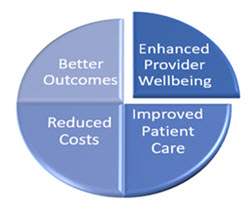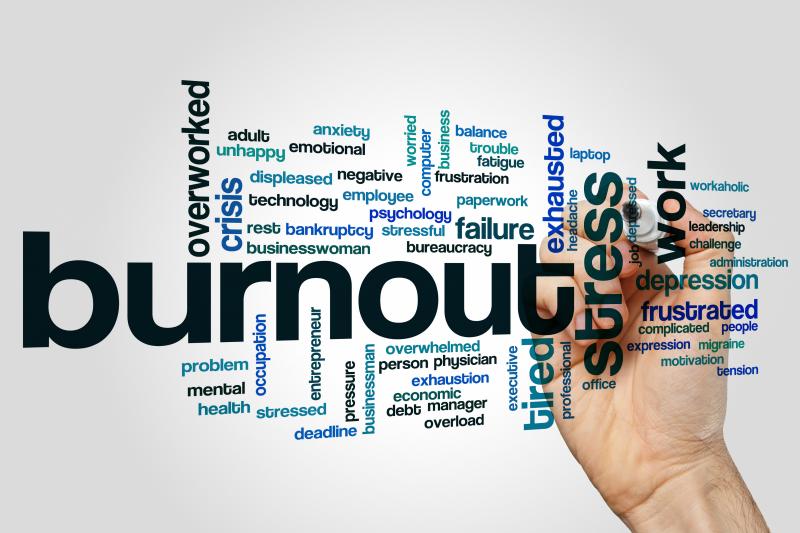An April 2021 survey by the Larry A. Green Center revealed that 7 in 10 primary care providers feel that burnout or mental exhaustion has reached an all-time high. We are, undoubtedly, experiencing an epidemic of burnout that has threatened our ability to enhance patient care, improve outcomes, and reduce costs – or the “Triple Aim.”
But even prior to the COVID-19 pandemic, it had become clear that, without promoting the well-being and resilience of health care providers, it is increasingly difficult to make positive impacts on any of the three pillars that have guided our health care systems for over a decade. The addition of enhanced provider wellbeing to the very compass of our health care institutions is an opportunity to fundamentally shift the way we approach optimizing health system performance.
But what, exactly, is “burnout” and why does It matter?

Broadly speaking, burnout is defined as “a psychological response to job stressors characterized by emotional exhaustion, detachment, and a sense of ineffectiveness” (Edwards et al., 2021). In practice, providers and other clinical staff suffering from burnout may be irritable, cynical, fatigued, dissatisfied or apathetic. They may be more likely to deliver lower quality of care, reduce their hours, or even stop practicing all together.
Clearly, this has direct effects on patients, practices and the system as a whole. In addition to its psychological impact on providers and other staff, burnout can increase medical errors, worsen patient outcomes and satisfaction, decrease productivity, and result in higher overall costs of care (Yates et al., 2019). And the physician turnover that may result from burnout can cost upwards of $250,000.
Burnout and Primary Care
Arguably, nowhere is the impact more prevalent than in primary care, where rates of burnout are some of the highest in the medical discipline. While its root causes are complex and varied, some of the key factors that make those working in primary care vulnerable to burnout include:
- Administrative burdens
- Loss of a sense of agency to regulatory and/or insurance entities
- Increasing EHR demands, complexity
- Financial strains and reimbursement pressures
- Turnover and workforce shortages
- More recently, lack of support and resources to cope with COVID-19-related stress
And this topic is especially relevant within the context of practice transformation. Primary care providers are being encouraged to transition to new models of care delivery. Not only are they often counter to the culture in which they were trained, but they require practices to establish a sustainable, productive workforce with leaders who are willing to put in the effort to create an environment of learning and development. All of that, unfortunately, is threatened when providers and staff are burnt out.
What Can We Do?
While the field of primary care is experiencing a burnout crisis, it is not inevitable, and, even for those who are already suffering, there are strategies that can be taken to improve wellbeing and to return to the commitment and joy in work that brought them into the field to begin with.
Again, burnout is a multi-faceted issue and there is no “one size fits all” approach to addressing it. However, there are a number of steps primary care practices can take to prevent and reduce the degree of burnout among providers and other staff members.
Individual Level
To be clear, burnout is a “process problem” as opposed to a “people problem,” but there are still strategies individuals can take to enhance their own wellbeing and resilience. That is, providers and staff members must practice what they preach – they must learn to care for themselves.
- Engage in whatever form of self-care feels right to you, though those that promote mindfulness have been found to be particularly useful in combatting symptoms of burnout.
- Establish healthy work-life boundaries.
- Unplug, both individually and as a team, from phones, charts, and other office demands.
- Express gratitude – when you feel depleted, it is easy to leave at the end of the day with complaints. But gratitude is known to improve resilience and attitude and can be a beneficial habit to create.
- Identify where you can say no at work as well as where you might be able to exert control in the office environment. This is especially important as providers increasingly feel a loss in agency and added regulatory barriers.
Organizational/Practice Level
Taking individual action will have little impact if providers and staff members are returning to the same environment that contributed to their burnout in the first place. Practices must look carefully at how they may be contributing to the problem and take bold actions to reverse it.
- Improve the culture and leadership of your practice
- Practice culture should emphasize teamwork, sensemaking, learning, and relationship building (Edwards et al., 2021). This includes encouraging communication, psychological safety, and mindfulness of others.
- Improve communication among your practice with regular team huddles and team meetings.
- Promote the use of positive humor as a way of improving mood, enhancing relationships, and promoting resilience.
- Leaders must model the behaviors and attitudes they hope to encourage in staff – those that promote wellbeing rather than fatigue and burnout.
- Record and examine the workflows, processes, and tasks taking place in your practice.
- Engaging in these activities can help practices identify:
- Where responsibility can be delegated elsewhere, taking some burden off providers and supporting team members to expand their role and work at the top of their licenses and abilities.
- Where tasks can be standardized, such as creating standard orders or otherwise optimizing EHR systems.
- Where duplicate work may be taking place and can be consolidated.
- Where opportunities to remove computer clicks, process steps, or other activities from the workflow entirely may exist.
- Knowing the workflow and the tasks that team members are engaged in will also support practices to shift responsibilities should a team member leave and assist in the onboarding of new team members as well.
- This, in addition to sufficient training, can also build the confidence of staff to take on their own role and step in elsewhere when needed to do what needs to be done for the team to thrive.
- Engaging in these activities can help practices identify:
- Consider, if resources allow, holding a practice retreat for all providers and staff where they can unplug together, build relationships, and improve communication and understanding.
- Activities that allow staff to briefly unplug and connect with one another, such as group walks during lunch, can make an impact on overall wellbeing.
Systemic Level
Any discussion on burnout would not be complete without highlighting the need to make changes at the larger systemic level. These are changes that will require large-scale, possibly national-level, efforts to implement but are crucial to having a true impact on the problem.
- Reduce the regulatory and documentations burdens on practices.
- Incentivize students to go into primary care to address workforce shortages currently being experienced in the field.
- Address burnout in the early career stage or training.
- Action by public and private payers to stabilize and sustain primary care (e.g., enhanced reimbursements).
- Support the improvement of usability and interoperability of health IT.
- Reduce the stigma of burnout – and mental health concerns broadly – that may prevent providers and staff from getting support.
Conclusion
Primary care – and the US health care system as a whole – needs providers and teams to take on transformation efforts and transition to new models of care delivery. However, burnout hinders their ability to be effective in leading and sustaining change. Action must be taken not only at the individual level, but at the organizational and systems levels as well.
Though we may be experiencing a crisis of burnout, it is not inevitable. HealthTeamWorks’ practice facilitators have had the opportunity to work with primary care practices as they implement some of the strategies mentioned above, and the addition of a new team member with content expertise in burnout has enhanced our awareness not only of the problem, but of the potential to make positive change toward solutions. If you or your practice are experiencing burnout and would like support, we are here to help.
Written by Katie Ebinger, MPH, MSW - Facilitator, Advancement & Healthcare Transformation, HealthTeamWorks
References
Larry A Green Center. (2021). Quick COVID-19 primary care survey: Series 28 fielded April 9-13, 2021. Available at
https://static1.squarespace.com/static/5d7ff8184cf0e01e4566cb02/t/608025b52bcda1342b1296b5/1619010998067/C19+Series+28+National+Executive+Summary.pdf
Edwards, S., Marino, M., Solberg, L., Damschroder, L., Stange, K.,…& Cohen, D. (2021). Cultural and structural features of zero-burnout primary care practices. Health Affairs, 40(6), 928-936.
Yates, S. (2019). Physician stress and burnout. American Journal of Medicine, 133(2), 160-164.









